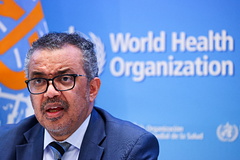WHO head Gebreyesus: omicron spreads faster than other strains, dangerous for vaccinated

Photo: Denis Balibouse / Reuters
Experts from the World Health Organization (WHO) have estimated the spread of the new omicron coronavirus strain. Recent evidence suggests that omicron spreads much faster than other types of infection. WHO Director General Tedros Adan Ghebreyesus announced this, RIA Novosti reports.
We now have strong evidence that the omicron spreads significantly faster than the delta strain

Tedros Adanom Ghebreyesus WHO Director General
Gebreyesus also confirmed that the virus is dangerous, including for those vaccinated and recovered from coronavirus infection.
Omicron strain
World Health Organization spokesman for the fight against COVID-19 David Nabarro noted that omicron is spreading extremely quickly.According to the WHO, the number of new cases doubles every two to three days.
This means the situation will be eight times more serious in a week and 40 times more serious in two weeks.

David Nabarro World Health Organization (WHO) COVID-19 Representative
At the same time, the main symptoms of the omicron-strain of coronavirus do not fundamentally differ from the previous strains. According to the WHO representative in Russia Melita Vujnovich, the list of the most common manifestations of the disease includes headache, fever and lung damage, there are complications that WHO has noted in all strains so far.
Thus, it is now clinically almost impossible to understand who fell ill with the omicron and who got the delta, the expert emphasized.
Vujnovic also suggested that the omicron strain of the coronavirus could become a “live vaccine” against COVID-19 and help defeat the pandemic. She noted that such an outcome is possible, but stressed that at the moment it is too early to talk about it, since there are not enough patients with omicron. “We have to wait at least a week and a half, so that we can tell for sure,” explained Vujnovich.
Forecast for the next year
According to WHO forecasts, the coronavirus pandemic may end as early as next year. However, Ghebreyesus stressed during the briefing, it will be possible to put an end to COVID-19 only by stopping the spread of the virus.
If we want the pandemic to end next year, we must end inequality and vaccinate 70 percent of every country's population by the middle of next year.

Tedros Adanom Ghebreyesus WHO Director General
Approximately the same time frame is set by the doctors of the Moscow City Clinical Hospital No. 52. According to them, the coronavirus pandemic could last another six months or a year.
In turn, the Director of the Regional Office for Europe of the World Health Organization (WHO) Hans Kluge expressed the hope that sooner or later there will be an evolution from a coronavirus pandemic to an endemic, as happened with the flu: then COVID-19 will become a seasonal respiratory virus, from which people need to be vaccinated once a year.
Situation in Russia
WHO Representative in Russia Melita Vujnovich noted that in Russia there are signs of reaching a plateau in COVID-19 and a change in the epidemic situation. At the same time, she drew attention to the fact that, despite reaching a plateau, the incidence rate in the country is very high, “close to 30 thousand cases a day.” “You can see good signs, but you shouldn't absolutely calm down,” Vujnovic urged.

